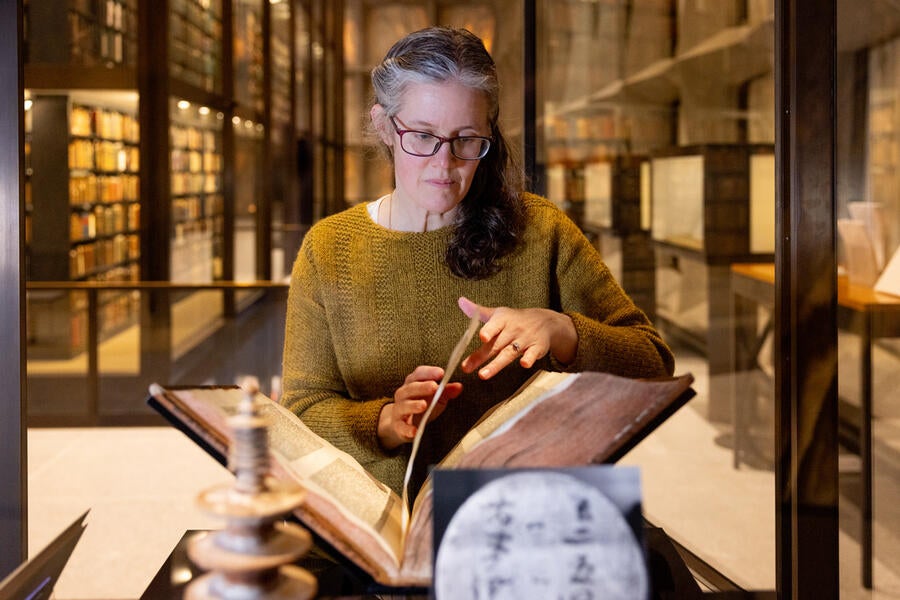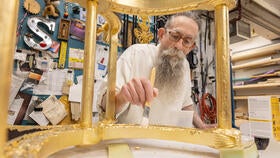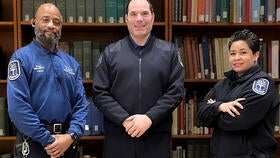
The Gutenberg Bible has been on display in a large bronze and glass case at the Beinecke Rare Book and Manuscript Library since 1963. At almost 600 years old, its typeface and illustrations are still vibrant, and the pages remain flexible, in no small part, because of the consistent care the Bible receives from Yale Library conservators.
Originally, both volumes of the Bible —the Old and New Testaments—were laid open and flat on custom-made pewter plates. About a decade ago, black plexiglass cradles were installed to replace the plates, better supporting the book structures and giving the volumes the appearance of floating inside the case.
“Books are made to be stored upright or flat when closed, but need support when open,” said Paula Zyats, head of Rare Books and Manuscript Conservation and Special Collections. “There is extra strain on the spine and sewing when any book is laid flat. This cradle keeps the Bible open at a gentle angle, easing that strain.”
A real page-turner

Other conservation efforts include turning the Bible’s pages quarterly, carefully rotating through the front, middle, and back of the book. The conservators open the specially made, humidity-monitored glass case and gently turn the pages by hand without removing the Bible from that space, but ever so slightly adjusting it to ensure it sits perfectly centered within the cradle.

“It’s stressful for an ancient volume to be positioned in one spot, so we redistribute that stress by turning the pages,” said Rebecca Hatcher, preservation librarian and registrar at Yale University Library. During this exercise, the conservators also check the environment and download data from the case’s humidity monitor. Air continually circulates through the glass case, keeping humidity low and mold at bay. “We want the Bible to be in a stable climate setting, not too dry or humid. Mold is everywhere in the air, and it can proliferate and do terrible harm to any of the old books in our collections,” said Hatcher.
The conservators try to select pages with ornamentation and gently position the book’s binding to allow it to sit snugly in the cradle. Its pages want to flutter shut, so a small piece of mylar holds them down, almost invisible to any viewer. While handling the Bible, the conservators take care not to speak, cough, or sneeze. “Neither of the volumes have ever been treated or gone out on loan; they’ve been at Yale for almost a century in our care and are in remarkable condition,” said Zyats.

The page-turning exercise minimizes, for conservation, the exposure any of the pages may receive (600+ in each volume) when being opened. This practice also allows visitors the chance to see different pages over time.
Keeping it in context
Since 2022, only one volume (currently the Old Testament) is on view at a time and shares the case with a 1,250-year-old print of Buddhist prayers — the earliest known printed text that can be reliably dated. “We started a new program that gives one of the volumes a break and opens display space for other printed pieces in our collections that put the Bible in context,” said Zyats.
“Many start by viewing the Bible before any of our other collections,” Zyats commented. “Our care and stewardship of these ancient volumes allows them to be enjoyed by future generations to see, study, and understand its historical significance.”
The Gutenberg Bible and Yale
Johannes Gutenberg printed about 180 copies of the Bible in Latin on both paper and vellum around 1455. It is the first significant book manufactured in the West using metal moveable type. Yale’s copy, printed on paper, is one of only 21 complete copies known to exist, and only five are in the U.S. It was gifted to the university in 1926 by Mary Stillman Harkness in memory of her mother-in-law, Anna M. Harkness.
The Beinecke Library’s exhibition hall is free and open to the public seven days a week. The collections are accessible to all who register to do research in the reading room on weekdays, and Yale Library’s digital collections are accessible to all online.
Both volumes of the Gutenberg Bible, the Old Testament and the New Testament can be viewed online.






